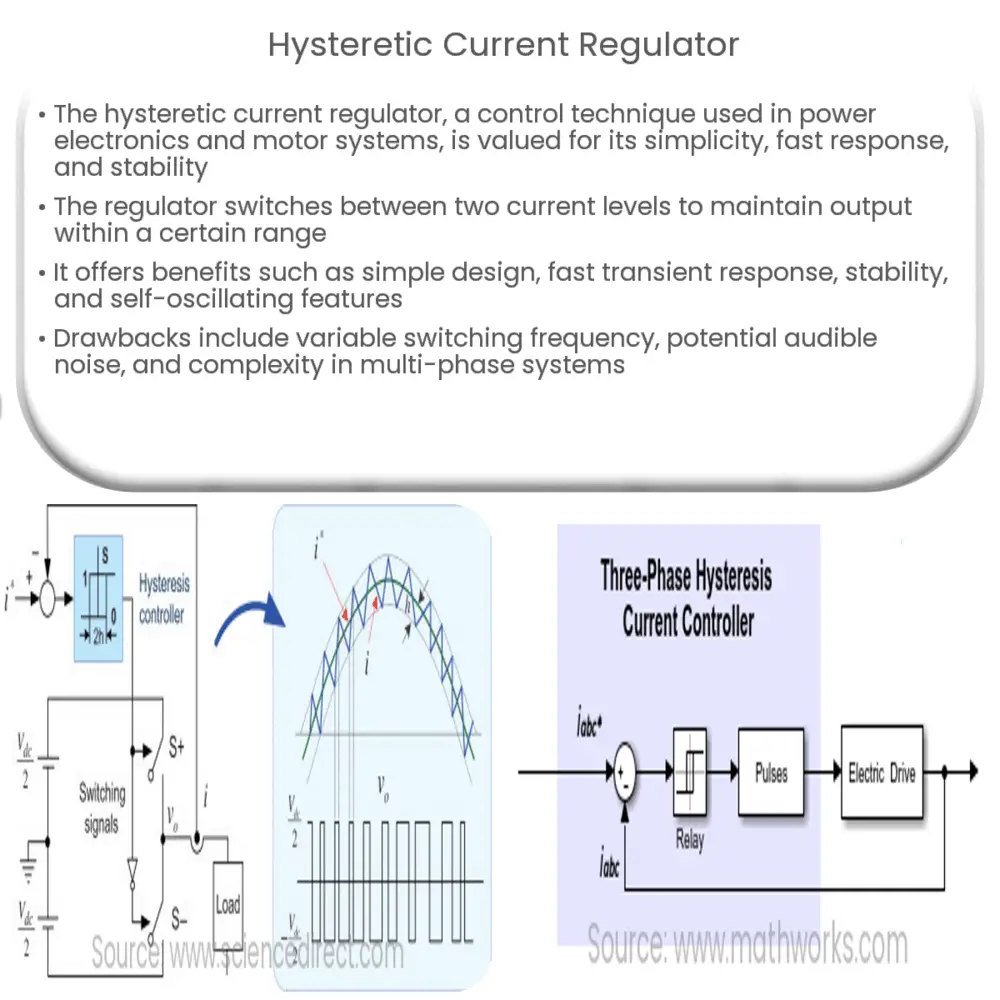A hysteretic current regulator is a control technique for regulating output current, offering simplicity, fast response, and excellent stability.

Hysteretic Current Regulator: An Overview
Introduction
The hysteretic current regulator is a control technique used in various applications, ranging from power electronics to motor control systems. This method has gained popularity in recent years due to its simplicity, fast transient response, and excellent stability characteristics. In this article, we will discuss the fundamentals of the hysteretic current regulator, its working principles, and its advantages and drawbacks.
Basics of Hysteretic Current Regulation
A hysteretic current regulator functions by switching between two distinct current levels, forming a hysteresis loop. The hysteresis loop enables the regulator to maintain the output current within a predefined range, ensuring that the current is regulated effectively. The system can be designed with either a fixed or adjustable hysteresis band, providing flexibility in the regulator’s performance to accommodate a wide range of applications.
Working Principle
The hysteretic current regulator operates based on a simple feedback loop, which compares the output current with reference current levels. When the output current exceeds the upper limit of the hysteresis band, the regulator switches off the power device, allowing the current to decrease. Conversely, when the output current falls below the lower limit, the regulator switches the power device back on, increasing the current. This continuous switching between on and off states ensures that the output current remains within the desired hysteresis band.
Advantages of Hysteretic Current Regulators
There are several advantages of hysteretic current regulators that make them an attractive choice for various applications. Some of these benefits include:
- Simple Design: Hysteretic current regulators have a relatively simple circuit design, which reduces the complexity of the control system and makes it more accessible to implement.
- Fast Transient Response: The on-off switching of the power device in a hysteretic current regulator allows for a rapid response to changes in the load current, ensuring that the output current remains within the desired range.
- Excellent Stability: Due to its inherent hysteresis band, a hysteretic current regulator can tolerate a wide range of input voltage and load current variations without requiring complex compensation techniques, leading to better overall stability.
- Self-Oscillating: Hysteretic current regulators are self-oscillating, meaning they do not require a separate clock signal to operate. This characteristic simplifies the control circuitry and reduces the overall system complexity.
Drawbacks of Hysteretic Current Regulators
Despite their advantages, hysteretic current regulators also come with some drawbacks that may limit their applicability in certain scenarios:
- Variable Switching Frequency: The switching frequency of a hysteretic current regulator varies with the load and input voltage, which can create challenges in meeting electromagnetic interference (EMI) requirements for certain applications.
- Audible Noise: The variable switching frequency of a hysteretic current regulator can sometimes generate audible noise, especially in applications like motor control, which may be undesirable in specific environments.
- Complexity in Multi-phase Systems: Implementing hysteretic current regulators in multi-phase systems can be more complex, as coordinating the hysteresis bands among various phases might be challenging to achieve the desired performance.
Applications of Hysteretic Current Regulators
Hysteretic current regulators are widely used in various applications, including:
- DC-DC Converters: In power electronics, hysteretic current regulators are commonly employed in both buck and boost converters to regulate the output current effectively.
- Motor Control Systems: Hysteretic current regulators are used in brushless DC motor (BLDC) and permanent magnet synchronous motor (PMSM) control systems, where they help maintain the motor current within a defined range, thus ensuring smooth and efficient operation.
- Battery Charging and Management: Hysteretic current regulators can be used in battery charging systems to control the charging current, ensuring that the battery is charged safely and efficiently.
- LED Drivers: In LED lighting applications, hysteretic current regulators are employed to regulate the current supplied to the LED, ensuring consistent brightness and minimizing color shifts.
Conclusion
In conclusion, the hysteretic current regulator is a simple yet effective control technique widely used in various applications, such as power electronics, motor control systems, battery charging, and LED drivers. Its simplicity, fast transient response, and excellent stability make it an attractive choice for designers. However, the variable switching frequency and potential for audible noise might limit its applicability in certain scenarios. To overcome these drawbacks, designers may need to consider alternative control techniques or implement additional measures to mitigate their effects.
Overall, the hysteretic current regulator remains a valuable tool for engineers and researchers seeking to develop efficient and robust current regulation systems across a broad range of applications.

